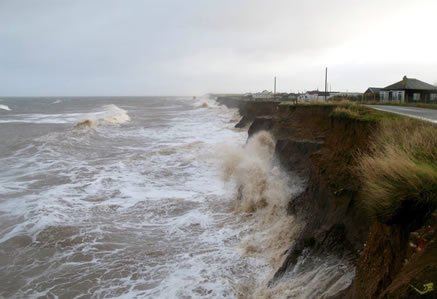The distance a wave has travelled.
Find out more about waves.
Constructive wave
Find out more about constructive waves.
Destructive waves
Find out more about destructive waves.
Backwash
Find out more about waves.
A wave is a disturbance on the surface of the sea or ocean, in the form of a moving ridge or swell.
Find out more about waves.
The wearing away of land by the sea.
Find out more about coastal erosion.
Corrasion is when destructive waves pick up beach material (e.g. pebbles) and hurl them at the base of a cliff. Over time this can loosen cliff material forming a wave-cut notch.
Find out more about coastal erosion.
Abrasion occurs as breaking waves, concentrated between the high and low watermarks, which contain sand and larger fragments wear away the base of a cliff or headland. It is commonly known as the sandpaper effect. This process is particularly common in high-energy storm conditions.
Find out more about coastal erosion.
Corrosion/solution is when certain types of cliff erode as a result of weak acids in the sea.
Find out more about the processes of coastal erosion.
Attrition is when waves cause rocks and pebbles to bump into each other and break up.
Find out more about coastal erosion.
Mechanical weathering is the breakdown of rock without changing its chemical structure (composition).
Find out more about weathering.
Chemical weathering is the breakdown of rock through changing its chemical composition.
Find out more about weathering.
Recently weathered rock can be seen at the foot of chalk and limestone cliffs and is easily identified because it is angular.
Find out more about weathering.
Weathering is the breakdown of rock in situ by the action of rainwater, extremes of temperature, and biological activity.
Find out more about weathering.
Freeze-thaw weathering occurs when rocks are porous (contain holes) or permeable (allow water to pass through). Water enters the rock and freezes. The ice expands by around 9%. This causes pressure on the rock until it cracks. Repeated freeze-thaw can cause the rock to break up.
Find out more about weathering.
Beach material is suspended and carried by the waves.
Find out more about coastal tansportation.
Beach material is bounced along the seafloor.
Find out more about coastal transportation.
Traction – large pebbles and boulders are rolled along the seafloor.
Find out more about coastal transportation.
Longshore drift happens when waves approach the beach at an angle. The swash (waves moving up the beach) carries material up and along the beach. The backwash (waves moving back down the beach) carries material back down the beach at right angles. This is the result of gravity. This process slowly moves material along the beach and provides a link between erosion and deposition. The material is transported through suspension, traction, solution and saltation. Longshore drift provides a link between erosion, transportation and deposition.
Find out more about longshore drift.
Wave energy reduces leading to material being deposited.
Find out more about coastal deposition.
Share this:
- Click to share on X (Opens in new window) X
- Click to share on Facebook (Opens in new window) Facebook
- Click to share on Pinterest (Opens in new window) Pinterest
- Click to email a link to a friend (Opens in new window) Email
- Click to share on WhatsApp (Opens in new window) WhatsApp
- Click to print (Opens in new window) Print

